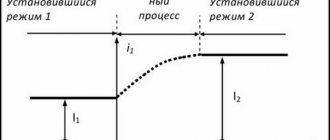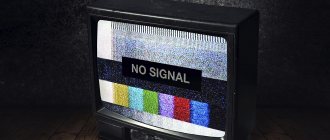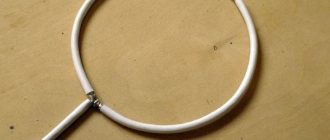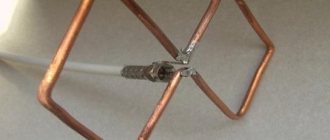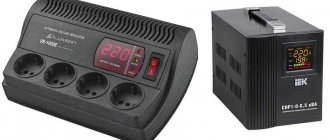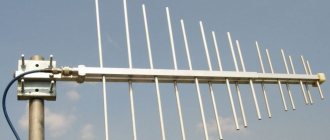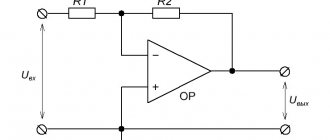Sometimes there are several TVs in an apartment. The incoming signal is distributed between them. At the same time, it is necessary to ensure the highest possible quality of video and audio on each of them. To fully use a TV signal divider, you should understand the principles of its operation and understand how to choose it correctly.
Splitter for television cables Source tvdigitally.ru
Device settings
When choosing, you need to take into account the technical parameters of the device:
- The attenuation level indicates how much the signal transmission power through this device is reduced. The smaller this value, the better the device works.
- A splitter is designed to distribute the incoming signal between several television receivers. Typically the number of recipients is from two to eight. It is important that the number of outputs corresponds to the number of pieces of equipment. There are also splitters for 16 recipients, but such models are relatively rare.
- Bandwidth characterizes the frequency range used. In most cases, for terrestrial television it is 5-1000 MHz, and for satellite television it is 5-2500 MHz.
- An active antenna splitter additionally uses an amplifier. It is capable of providing increased power during signal transmission. Such devices are more expensive and can work with no more than two devices.
When choosing a splitter, its parameters must correspond to the specific situation of the buyer. If not all connectors will be used, it is recommended to install plugs on the remaining ones.
The device indicates the degree of signal attenuation for each connector Source stroy-podskazka.ru
Varieties
Various types of structures are used, each of which has its own characteristics. When choosing, you need to take into account that the preference depends on the tasks facing the user.
Splitter
This device divides the incoming signal into the required number of consumers. At the same time, its characteristics change accordingly. This can be illustrated with the following example. If the input signal has a level of 12 dB, then when divided into two TVs, each of them will receive 6 dB. For three, this value will be equal to 4 dB.
The use of a threaded connection ensures a reliable connection Source stroy-podskazka.ru
Couplers
This design is used for signal conversion in apartment buildings. At the same time, it is distributed to each floor by splitters. And then to each apartment using taps. Here, two outputs are usually used, and the signal on one of them is more powerful. The latter can be used to connect another similar device. The cable from the weaker output will be used to transmit the signal to the apartment.
Adders
They can be used to simultaneously work with terrestrial and digital channels. It can only work with two consumers. If one of the receiving devices is disabled, it will still be possible to use the other.
Using different types of plugs Source stroy-podskazka.ru
Types of splitters and their areas of application
A digital TV signal splitter performs the task of matching circuits when connecting two consumers to one source . There are several types of such devices with different recommendations for use.
- A linear antenna divider for digital terrestrial television evenly divides the signal into several consumers. At the same time, depending on the quality of the device, the level drop rate ranges from 1.44 to 2 and higher (for two TVs). A line splitter can have several outputs and only one input. So, a crab splitter can connect three TVs at once.
- An antenna splitter for digital television works differently. At one of its outputs, it generates a signal with nominal values, the strength of which depends on the input parameters. Roughly speaking, the rest of the pie is sent to other consumers. And the more there are, the lower the signal level at each.
- The adders work in reverse order. They have several inputs and one output. Such a device allows you to coordinate signals from a group of antennas and direct them to one consumer.
Splitters and splitters are divided according to their operating range. Devices with frequencies up to 1000 MHz are better for cable TV and digital terrestrial signals. They are inexpensive and available in a huge number of models from different manufacturers. Products with operating frequencies up to 2400 MHz show good results when processing satellite TV.
Splitters can be active or passive. The latter greatly reduce the signal level and are not able to provide the declared characteristics at low input parameters.
Important! Active splitters or splitters for TV are more efficient. They have built-in amplifiers and provide stable output levels. However, such a device will require power supply or plugging into an outlet.
How to choose
It is important to understand that the more receiving devices, the more the incoming signal will weaken. This is acceptable in cases where it is initially high. If this is not the case, then you need to choose an active antenna splitter. It is advisable to install it next to the receiving antenna.
First you need to determine the required device parameters. To do this, go to the settings and look at the frequencies of the channels used. It is important that the upper threshold of the range is above this frequency.
You need to take into account the number of television receivers available and think about whether you plan to buy new equipment. If this is the case, then splitter outputs must also be provided for them. Their quantity in the purchased device must correspond.
When purchasing, you need to evaluate the appearance of the device. If you plan to place it in a special box, then you need to select the dimensions so that it can fit there.
The TV body may have a place to mount the device. If they plan to fix it here, the splitter needs to match it. It is unacceptable to attach it in such a way that it dangles freely.
When purchasing, you need to determine the types of connectors available. They must match the existing cables. Having made your choice, it is recommended to look on the Internet to see which models are suitable. If necessary, you should prefer an active splitter.
Determining the frequency of the channels used for the correct choice of splitter Source lampa-ekb.ru
Purpose and main differences
Splitters allow you to evenly divide a television signal between several outputs. For example, if the input signal level was 12 dB, then at the outputs of a double divider it will be 6 dB, a triple divider - 4 dB, and a quad divider - 3 dB.
Double splitter
The figure shows a schematic representation of a double splitter, where:
A – signal input;
B and C are the exit.
Antenna splitters of this type are used in cases where it is necessary to send a signal to 2 or 3 TVs, or more if the device has an amplifier (active splitter). An example is the model of the Polish manufacturer ARA-01A.
Diplexers allow you to combine two signals into one. Most adder models are universal; they can work in two directions, that is, act as an adder or a divider.
Dual diplexer
The figure shows a schematic representation of a double diplexer, where:
A and B – input signals;
C – output signal.
A diplexer is used in cases where it is necessary to run a signal from a satellite and a conventional antenna over one cable or combine signals from different ranges. The figure shows an example of using an adder and a divider together, where:
- A – television antenna;
- B – satellite dish;
- C – adder;
- D – socket with a built-in divider for connecting two television cables.
. Taps are used to organize a backbone television network, for example, to divert a signal to apartments in a multi-story building.
Highway organization diagram
The figure shows an example of organizing a highway using several taps, where:
- A – incoming signal;
- B, C, D, E, F, G, H, I, J – signal output (tap), for example, to each floor of a nine-story building.
As can be seen from the connection diagram, such devices have one pass-through output, from which the signal is supplied to the input connector of the next coupler.
Video: TV antenna splitter.
Antenna splitters can also include a range blocker (stub), which is widely used by cable television operators to separate social and paid connection packages.
In everyday life, splitters are most often used; they are used to connect several televisions to the antenna cable entering the apartment; the quality of the television signal directly depends on these devices.
Principle of operation
At first glance, it may seem that you can directly connect several output cables to an input cable. In fact, although this will work, it will make the signal so low quality that it will be impossible to watch.
The fact is that each cable has a certain characteristic impedance. They will be different for the input and output. If they are connected to another using twisting, then part of the signal will pass through it, and most of it will be reflected. The device is designed in such a way that the loss of quality during transmission is minimal. An active antenna TV splitter can completely compensate for the loss of signal quality.
Connecting two TVs to a TV divider Source paes250.ru
How to choose a splitter
Passive type splitters are considered the most common. They are popular due to their simple design and low cost. Passive products solve the issue of wiring if there are two TVs in the house. It is worth considering that with such a connection the signal is halved, and if you connect three or more TVs, then each receiver will receive only 1/3 or 1/4 of the antenna signal level.
If you need to connect television to 4 TVs, it is recommended to pay attention to active splitters. They, in turn, are divided into two types: the first has an additional output for power, and in the second case, the same high-frequency cable through which the signal from the antenna passes is used for power. The main advantage of active splitters is that at all its outputs the same signal level is observed, equal to 1.1-1.3 (unlike the one present at the input).
When choosing a television splitter, you also take into account what type of broadcasting you need to connect. For digital TV, the operating frequency of the product is about 1 GHz, while for satellite broadcasting the frequency range increases to 2.5 GHz. When purchasing a splitter, it is recommended to pay attention to another important parameter - signal attenuation. This characteristic is indicated on the device body, and the lower its value, the less signal loss there will be. When choosing a divider for 3 or 4 TVs, you must adhere to the following recommendations:
- Determine the frequency of received channels. This can be done using the menu of your TV receiver or visit the website rtrs.ru and find the necessary information using an interactive map online. When purchasing a splitter, you need to take into account the channel with the highest frequency and select a device whose frequency range covers these indicators.
- Possible prospects should also be taken into account. It is best to purchase a divider whose number of outputs will exceed the number of televisions.
- Appearance and size play a significant role for some users. It is important that the device looks aesthetically pleasing if it is located in a visible place. If you plan to place the device in a cable box, it is better that it be small.
- There are several connection options, depending on the type of cable, as well as the possibility of soldering.
- An important characteristic is the level of attenuation. It is measured in decibels, and its value is usually indicated on the body of the device.
If you take into account all the above-described nuances when purchasing a divider, problems with its operation should not arise in the future.
Making a connection
Please note the following when connecting cables:
- If the device has coaxial jacks, then you can connect any type of cable to them using regular antenna plugs.
- When threaded connections are present in the splitter, it is assumed. That the connection will be made using a thin cable.
- For screw terminals, any type of cable can be used.
In order to make a connection, you must perform the following steps:
- Secure the splitter using the chosen method. This can be done by mounting it on the wall, fixing it on the TV receiver mounts, in a special niche, or in a plastic box.
- The rivets must be removed from each splitter connector.
- Cables from TVs are connected to the corresponding sockets.
- Insert the antenna cable.
After this, you can start viewing available programs. After installation is complete, you need to check the image quality. If it is not high enough, it is recommended to use a more powerful antenna, or use an active TV divider.
Using dividers in an apartment
It is necessary to pay attention to the location of devices inside the apartment. The installation rules depend on the connection structure. It can be equilibrium or nonequilibrium. It is convenient to illustrate this with the following example.
Splitter for connecting three TVs Source paes250.ru
The television signal enters the apartment via one cable. The receivers are at the same distance from him. In this case, you can use a simple divisor. Which will divide the input signal into several identical ones.
If the TVs are located at different distances from the input cable, the connections will have different lengths. Thus, the closest signal will be of the highest quality, and the most distant signal will be of the least quality. There is a nonequilibrium structure here.
Scheme for using TV splitters Source 220v.guru
In this case, a coupler is used that will split the signal into two, one of which is strong and the other relatively weak. The last one is for the nearest TV receiver, and the other is for the next coupler. This scheme will allow you to get maximum video and audio quality on all available devices. Splitters will allow you to redistribute the power of the input signal.
When using a splitter, you must choose a suitable location for it. It is important to keep the cable length to a minimum. When using three or more TVs, the signal is expected to become quite weak. This will allow you to watch analogue channels, but not digital ones.
Antenna divider for two inputs with plugs Source art-liga.rf
For the latter, high signal quality is critical. In this case, it is recommended to use an active splitter. It will enhance the input signal to the required extent. It should be taken into account that signal amplification can also be done immediately after the antenna.
The more outputs the divider has, the stronger the attenuation will be. Therefore, it is not recommended to purchase a device that has more sockets for connection than necessary. If there are only two TVs, it is not recommended to take the device for 3 or more television receivers. When using it, not only signal weakening can occur, but also image ghosting. The latter is due to the presence of empty connectors. To avoid this effect, a plug with a resistance of 75 Ohms is placed on the free connector, which simulates a connected load.
Connecting a TV splitter Source stroy-podskazka.ru
Installation Rules
The rules for installing dividers on two, three or more digital broadcast televisions are based on the structure of the cable network. It can always be considered as a collection of several segments with one of two standard types.
Equilibrium structure
The most clear example of a balanced network is an antenna installed on the roof and cable routing through the ceiling of the top floor of the house. In this case, the length of the leads to the consumers is almost the same. This means that it is enough to install dividers to evenly distribute the signal between TVs.
Nonequilibrium structure
You can understand what a nonequilibrium structure is using the example of a multi-room apartment. At one point there is a digital television cable. From it to the first consumer there is a short line, to the next a longer and record length line to the TV in the farthest room.
In this case, it is recommended to install splitters and create a uniform signal distribution. For simplicity, let's look at an example with three TVs. The first splitter is installed at the entrance (apartment cable). Its low-power branch is switched to a short line. The main output is connected to the next splitter. Its powerful signal is sent to the long line, a branch to the remaining one.
Advice! In a complex network, it is always recommended to simplify to simple segments. In this case, it is worth taking into account the number of consumers in each and, if there is an obvious imbalance, use signal splitters to redistribute power.
